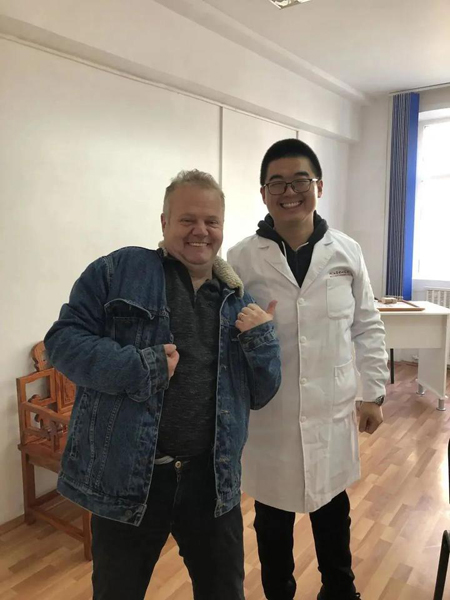TCM readily winning acceptance overseas

Li Xiao and his foreign patient. [Photo/zjol.com.cn]
Traditional medicine plays important role in fight against COVID-19 abroad
After practicing traditional Chinese medicine for seven years in Hangzhou, Zhejiang province, Li Xiao arrived in Romania in early February to treat patients on foreign soil for the first time.
"I did not expect TCM to be so welcomed by locals," said Li, from the Third Affiliated Hospital of Zhejiang Chinese Medical University. "Every day we had full appointments despite limitations on the number of patients due to the COVID-19 pandemic."
Although he has a certificate to practice TCM in China, Li had to get one authorized by the Romanian government before he could practice at a TCM center at Vasile Goldis Western University of Arad, in Arad county, western Romania. The center was established by the university and Zhejiang Chinese Medical University in December.
Li, a practitioner of acupuncture and tuina, a traditional, massage-like body therapy, found most of his patients had conditions such as cervical vertebrae syndrome and slipped disks that he said modern medicine had failed to resolve. To his surprise, he found the TCM techniques seemed to work on foreigners better than on Chinese.
"Back in Hangzhou, patients with such conditions may see improvement after five or six sessions of tuina, but the patients from Arad said they could feel their ailments relieved after just one or two," Li said. "Most of my patients in Arad had never received TCM therapies, so they may have been more sensitive to them."
Despite great demand, there was a severe shortage of professional TCM practitioners in Romania, and it was rare to see a Chinese TCM practitioner with professional training in Arad, said Li, who returned to Hangzhou in July.
As more TCM doctors go abroad to practice and international exchanges become more frequent, the ancient Chinese medical system, which has been practiced in China for thousands of years, is bringing health benefits to more people around the world.
By the end of last year, TCM had spread to 183 countries and regions, and TCM cooperation between governments and education sectors in China and other countries had intensified, according to the National Administration of Traditional Chinese Medicine. Nearly 10,000 overseas students are admitted to Chinese universities to study TCM every year, and TCM courses have also been opened in more countries.
Overseas TCM centers, such as the one set up in Vasile Goldis Western University, are a major way to promote TCM international exchanges and cooperation. More than 30 are operating in Europe, North America, Africa, Australia and other parts of Asia.
The centers and their Chinese partners had cooperated in 388 projects in nearly 90 countries by December, including the training of overseas TCM practitioners.
TCM has become increasingly popular overseas in the five years since the first overseas TCM center was built, said Song Xinyang, deputy director of the TCM International Development Research Center at Shanghai University of Traditional Chinese Medicine. By the end of last year, more than 1 million foreigners had received treatment at such centers, he said.
Most of the centers are in countries and regions that are home to a large number of people of Chinese descent, including some European countries, Southeast Asia and the United States, Song said.
"TCM did not take root in these countries in a day," he said. "It has spread overseas with the footprints of Chinese immigrants over the past few centuries and has proved its value."
-
Xixi Wetland invites visitors to Huazhao Festival
March 25, 2025
-
Hangzhou sets standard for concert hosting
March 19, 2025
-
What is making Hangzhou the new tech powerhouse of China?
March 10, 2025
-
Inside Hangzhou: China's high-tech dream factory
March 12, 2025



